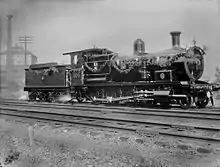New South Wales D53 class locomotive
The D53 class was a class of 2-8-0 steam locomotives built for the New South Wales Government Railways of Australia.
| New South Wales D53 class | |||||||||||||||||||||||||||||||||
|---|---|---|---|---|---|---|---|---|---|---|---|---|---|---|---|---|---|---|---|---|---|---|---|---|---|---|---|---|---|---|---|---|---|
 Class D53 Locomotive | |||||||||||||||||||||||||||||||||
| |||||||||||||||||||||||||||||||||
| |||||||||||||||||||||||||||||||||
| |||||||||||||||||||||||||||||||||
| |||||||||||||||||||||||||||||||||
History
This class of locomotive was designed by the New South Wales Government Railways as an improved version of the T class. All the coupled wheels had flanges and a certain amount of side movement was given to the middle pairs with a laterally operating knuckle joint being provided in the middle section of the coupling rods.
Clyde Engineering delivered the first locomotive in April 1912 and by November 1917, a total of 190 were in service. Most were fitted with superheaters when built and some fitted at a later date. There was a problem with the locomotives being unbalanced, causing speed restrictions to be imposed to avoid rough riding and track damage. Following further investigations, 24 of the class received balanced coupled wheels and these were permitted to operate at higher speed on mail and fruit trains.[1][2]
When introduced, most of the class were fitted with a standard bogie tender, similar as those attached to the 50 class, although some saw service with large capacity "Wampu" tenders. In the later period of their lives, the majority were fitted with larger turret type tenders. In later years some were used as heavy shunting locomotives and from 1963 on some of these had automatic couplers fitted to the front.[2]
Following the removal of the knuckle joints from the coupling rods, flanges from the second coupled and driving wheels and the fitting of boilers standard for 50 class; 53 class and 55 class, they became most useful locomotives.[2]
The 24 not fitted with superheaters were scrapped in the 1930s. The first superheated example was withdrawn in January 1957 with the fleet down to 39 by July 1969 with the last withdrawn in January 1973.[1]
The Commonwealth Railways used the design of these locomotives for their 26 strong KA class for the Trans-Australian Railway.[2]
Preservation
Three have been preserved:
| Number | Builder | Year | Owner | Location | Status | References/Notes |
|---|---|---|---|---|---|---|
| 5353 | NSWGR | 1913 | Dorrigo Steam Railway and Museum | Dorrigo | Stored | [3] |
| 5367 | Clyde Engineering | 1914 | Lachlan Valley Railway | Cowra | Under overhaul | [4] |
| 5461 | Clyde Engineering | 1916 | Transport Heritage NSW | Valley Heights | Static Display | [5] [6] |
Locomotive 5461 is fitted with the last "Wampu" style tender and was known as 1174 in the pre 1924 numbering scheme,1174 was known to be an exceptionally bad steamer and was the subject of many poems
Gallery
 200th steam locomotive built by Clyde TF 1164 from The Powerhouse
200th steam locomotive built by Clyde TF 1164 from The Powerhouse Locomotive 5395 stands at Thirroul with a Workers' Train from Port Kembla
Locomotive 5395 stands at Thirroul with a Workers' Train from Port Kembla
References
- Oberg, Leon (1984). Locomotives of Australia 1850's - 1980's. Frenchs Forest: Reed Books. pp. 107–108. ISBN 0 730100 05 7.
- Grunbach, Alex (1989). A Compendium of New South Wales Steam Locomotives. Sydney: Australian Railway Historical Society, NSW Division. pp. 152–155. ISBN 0 909650 27 6.
- "Preserved Steam Locomotives Down Under - 5353". www.australiansteam.com. Retrieved 9 May 2020.
- "Preserved Steam Locomotives Down Under - 5367". www.australiansteam.com. Retrieved 9 May 2020.
- "Locomotive, Steam 5461 | NSW Environment, Energy and Science". www.environment.nsw.gov.au. Retrieved 9 May 2020.
- "Locomotive 5461". infobluemountains.net.au. Retrieved 9 May 2020.